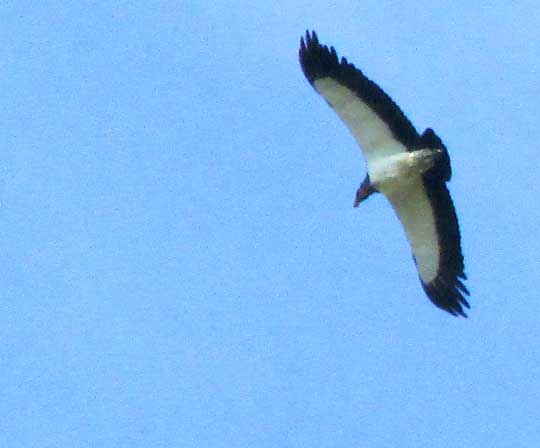Excerpts from Jim Conrad's
Naturalist Newsletter
from the November 23, 2014 Newsletter issued from Río Lagartos, on the Yucatan Peninsula's northern coast (~N21.60°, ~W88.16°), Yucatán state, MÉXICO
KING VULTURE
Not many birders get to see King Vultures, SARCORAMPHUS PAPA, because they're so rare, and disappearing along with the heavy tropical forests they need. They're native from southern Mexico to Northern Argentina, though in most of that area they've disappeared. With larger wingspreads than Turkey Vultures -- up to 76inches (82cm) -- and stockier, plus, being mostly white instead of the usual "vulture black," they're impressive birds. When serious birders sign up for a tour with my host Diego Nuñez, often the top bird on their dream list is the King Vulture.
That was the case the other day when some folks from the US, Diego, and I were out canvasing the transition zone between the marshes and savanna. Diego's incredibly sharp eyes picked up two tiny dots circling over the mangroves, slammed on the brakes and declared them to be King Vultures. Even with binoculars at that distance I couldn't distinguish them from similarly black-and-white White Pelicans, but the dots were drifting our way, so before long we could all see that they were King Vultures. A few minutes later yet a third turned up, this time circling right above so close that even with my little camera I could get the picture shown below:

Diego had spotted King Vultures in the same place before and at the same time of year, so we're hoping that the birds are thinking of settling here. If that happens, birders from all over will flock here to see them. Diego and the US birders had camera lenses over a foot long, enabling them to capture's the bird's rainbow head colors, the white eyes, bright orange eye circles, yellow wattle, red bill, on mostly dark gray skin, all so colorful it looked made-up. It was a birdwatcher's dream.
King Vultures eat anything from cattle carcasses to beached fish and dead lizards, and they've been reported to kill and eat injured animals, newborn calves and small lizards. They're known to find their food with vision, but it's debated whether they can locate carrion by smell the way Turkey Vultures can.